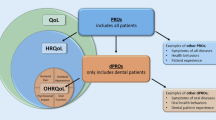Abstract
Oral health-related quality of life (OHRQoL) is expected to be multidimensional. However, it is unknown what these dimensions are. This study aimed to explore the dimensional structure of OHRQoL using experts–opinions. A conceptual model of oral health with seven dimensions (functional limitation; physical pain; psychological discomfort; physical, psychological, social disability; handicap) was provided to 14 health care professionals. They assigned each of 49 items of an OHRQoL questionnaire, the Oral Health Impact Profile (OHIP), to the seven model dimensions. All 49 items could be assigned to one or more dimensions of OHRQoL. All seven dimensions of the conceptual model of oral health were identified: Functional limitation appeared 14 times, physical pain eight times, psychological discomfort 12 times, physical disability once, psychological disability four times, social disability nine times, and handicap once. This supported a seven-dimensional model of OHRQoL. However, when items were grouped into clusters with unique content, a smaller model appeared with the dimensions oral functions, orofacial pain, psychological impact, and social impact.



Similar content being viewed by others
References
Gilbert, G. H., Duncan, R. P., Heft, M. W., Dolan, T. A., & Vogel, W. B. (1998). Multidimensionality of oral health in dentate adults. Medical Care, 36, 988–001.
Locker, D. (1988). Measuring oral health: A conceptual framework. Community Dental Health, 5, 3–8.
Slade, G. D., & Spencer, A. J. (1994). Development and evaluation of the Oral Health Impact Profile. Community Dental Health, 11, 3–1.
Wong, M. C., Lo, E. C., & McMillan, A. S. (2002). Validation of a Chinese version of the Oral Health Impact Profile (OHIP). Community Dentistry and Oral Epidemiology, 30, 423–30.
Larsson, P., List, T., Lundstrom, I., Marcusson, A., & Ohrbach, R. (2004). Reliability and validity of a Swedish version of the Oral Health Impact Profile (OHIP-S). Acta Odontologica Scandinavica, 62, 147–52.
John, M. T., Patrick, D. L., & Slade, G. D. (2002). The German version of the Oral Health Impact Profile–translation and psychometric properties. European Journal of Oral Sciences, 110, 425–33.
Szentpetery, A., Szabo, G., Marada, G., Szanto, I., & John, M. T. (2006). The Hungarian version of the Oral Health Impact Profile. European Journal of Oral Sciences, 114, 197–03.
World Health Organization (1980). International classification of impairments, disabilities, and handicaps. Geneva: World Health Organization.
John, M. T., Hujoel, P., Miglioretti, D. L., Leresche, L., Koepsell, T. D., & Micheelis, W. (2004). Dimensions of oral-health-related quality of life. Journal of Dental Research, 83, 956–60.
Norman, G. F., & Streiner, D. L. (2000). Biostatistics–the bare essentials (2nd edn.). Hamilton: B.C. Decker.
Ware, J. E. Jr. (1995). The status of health assessment 1994. Annual Review of Public Health, 16, 327–54.
Keller, S. D., Ware, J. E. Jr., Bentler, P. M., Aaronson, N. K., Alonso, J., & Apolone, G., et al. (1998). Use of structural equation modeling to test the construct validity of the SF-36 Health Survey in 10 countries: Results from the IQOLA Project. International Quality of Life Assessment. Journal of Clinical Epidemiology, 51, 1179–188.
Cushing, A. M., Sheiham, A., & Maizels, J. (1986) Developing socio-dental indicators–the social impact of dental disease. Community Dental Health, 3, 3–7.
Leao, A., & Sheiham, A. (1996). The development of a socio-dental measure of dental impacts on daily living. Community Dental Health, 13, 22–6.
Strauss, R. P., & Hunt, R. J. (1993). Understanding the value of teeth to older adults: Influences on the quality of life. Journal of the American Dental Association, 124, 105–10.
Gift, H. C., Atchison, K. A., & Dayton, C. M. (1997). Conceptualizing oral health and oral health-related quality of life. Social Science & Medicine, 44, 601–08.
Tapsoba, H., Deschamps, J. P., & Leclercq, M. H. (2000). Factor analytic study of two questionnaires measuring oral health-related quality of life among children and adults in New Zealand, Germany and Poland. Quality of Life Research, 9, 559–69.
Nuttall, N. M., Slade, G. D., Sanders, A. E., Steele, J. G., Allen, P. F., & Lahti, S. (2006). An empirically derived population-response model of the short form of the Oral Health Impact Profile. Community Dentistry and Oral Epidemiology, 34, 18–4.
Atchison, K. A., & Dolan, T. A. (1990). Development of the Geriatric Oral Health Assessment Index. Journal of Dental Education, 54, 680–87
McGrath, C., & Bedi, R. (2001). An evaluation of a new measure of oral health related quality of life–OHQoL-UK(W). Community Dental Health, 18, 138–43
Bagewitz, I. C., Soderfeldt, B., Nilner, K., & Palmqvist, S. (2005). Dimensions of oral health-related quality of life in an adult Swedish population. Acta Odontologica Scandinavica, 63, 353–60.
Fleiss, J. L., Levin, B., & Paik, M. C. (2003) Statistical methods for rates and proportions (3rd ed.). Hoboken, New Jersey: John Wiley & Sons
Locker, D. (1996). Applications of self-reported assessments of oral health outcomes. Journal of Dental Education, 60, 494–00
Acknowledgements
We would like to thank Drs. Buchmann, Dette, Heinrich, Müller, Rösel, Setz, Szentpétery, Töpel, Zwijnenburg (all currently or previously working in the Department of Prosthodontics, Martin Luther Universität Halle-Wittenberg, Germany) and Drs. Dauer, Liedtke, Rosendahl, and Selle (all currently or previously working in the Institute of Medical Psychology, Martin Luther Universität Halle-Wittenberg, Germany) for their participation in the study. We are grateful to Dr. Sobotta, University of Leipzig, for his comments to an earlier version of this manuscript.
Author information
Authors and Affiliations
Corresponding author
Rights and permissions
About this article
Cite this article
John, M.T. Exploring dimensions of oral health-related quality of life using experts–opinions. Qual Life Res 16, 697–704 (2007). https://doi.org/10.1007/s11136-006-9150-8
Received:
Accepted:
Published:
Issue Date:
DOI: https://doi.org/10.1007/s11136-006-9150-8




